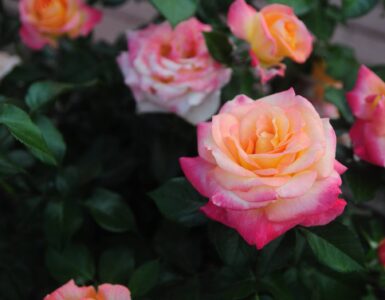Darin Engh, from Engh Gardens, shares several different ways to add some grass to your landscape, giving ideas and methods to try in your own yard.
Water-wise gardens may have a reputation for being sparse and plain, but this garden demonstrates that unthirsty border plants can be extraordinarily beautiful. The ornamental grasses give beds a sense of constant motion, while daylilies soften pathway edges and dark-leafed trees provide the perfect backdrop to the array of textures and forms. The many shades of green are set off by gold, maroon, and magenta. Grasses look right at home lining a pathway. They soften hard edges and unify the space, providing interest throughout the growing season. In addition, many ornamental grasses have flowers that can add color and texture.
It’s generally said that grasses have succeeded as a group because of their adaptability. They have evolved to suit almost every environment and climate on earth, from high mountain meadows to deserts, bogs to prairies, shady woodlands to shifting sands.
Filling In – Many low-growing clumping grasses make excellent edging plants for perennial beds; surrounds for features such as specimen trees, lights, or birdhouses; or simply naturalistic plantings. For the most dramatic appearance, choose just one species for edging around a particular bed. Space the plants so they’ll touch each other of mingle with surrounding plants when they have reached their mature size.
Light and Movement – The flower and seed heads they sport give grasses characteristics not shared by many other garden ornamentals. First, they are remarkably lightweight, swaying and dipping with the wind. Second, they have an ability to catch light in ways that other plants cannot. Consider the angle and timing of the light when positioning your grasses in the garden. Do you like to sit outdoors at sunset? Then why not plant a bank of waving miscanthus just above the horizon view? Or perhaps you are a morning person, who enjoys a variety of backlit grassy flowers dotted around the breakfast patio.
Winning Combinations – Of all companion plants, flowering perennials seem naturally to blend well with tall grass. Those similar lanky stems and small flower heads, such as lavender, Russian sage, or gaura, make ideal companions in sun-drenched western gardens. Those plants that form mounds of long-lasting blooms, such as penstemon, coneflowers, or rudbeckia, are ideal for mass plantings of five or more of each plant. Flowers with strong punctuations of color, such as dahlias, daylilies, and even phlox and salvias, show up beautifully against a foil of grassy foliage. Among the most important dictates of companion planting is to group species with similar cultural needs close together.
Specimens and Accents – Because of their height, particularly when they are flowering, many grasses and grass-like plants are ideal for use as single focal points in the garden. The large miscanthus, pampas grass, and clumping bamboos are commonly planted in this way, serving as punctuation marks beside a pond or a path, or as devices to draw the eye in the distance.
Screens – A good screen must have several characteristics. It must be dense, tall, and fast growing. In most cases, it is best if the screen is evergreen, to provide year-round visual protection from nearby utilities, sheds, or other dwellings. Many grasses fit this description and offer an added bonus: their rustling foliage can also provide a pleasant low level of sound to drown our objectionable noises, such as passing traffic.
Grasses in Masses – Many of garden lovers have come to recognize the signature sight of grasses planted in grand sweeps. Even if you don’t have the space for grand-scale mass plantings, there are effects you can achieve by grouping plants together even in smaller gardens. For a true massed effect, plant odd-numbered specimens in groups, spacing them far enough apart to allow for their quick growth.
Proven Selections Grasses
Zebra Rush (Scirpus zebrinus)
Full to part sun. 36-48″ tall.
Thin green reeds with creamy bands. Forms neat clumbs.
Adds vertical interest to ponds.
‘Strawberries and Cream’ Phalaris arundinacea
Full sun. 18-36″ tall 18-24″ wide. A very attractive ribbon grass. Green and white foliage; during cool seasons, its foliage will be blushed with pink. Stems are white as is the flower spike. Grows well in moist, wet conditions, and in poorly drained soils. Grow in partial sun to full shade. Fast spreader. A vigorous grower, and considered deer resistant once established. Excellent for erosion control, and makes an excellent container plant.
Tolerates sandy or rocky soil.
‘Marie’s Fescue’ Festuca mairei
Full sun to partial shade.
8-20″ tall 10-16″ wide. Beautiful architectural grass has a neat, uniform appearance. Drought tolerant.
Northern Lights (Deschampsia caespitosa)
Part sun. 8-14″ tall. Northern Lights is a cool-season grass. Cool-season grasses put on most of their growth in spring before temperatures begin exceeding 75 degrees Fahrenheit and in the fall when temperatures cool down.
They generally maintain good color through the summer. Cut back cool season grasses in very early spring. Cool season grasses tend to look good even as the weather cools. Leave their foliage in place until spring and then as soon as the snow is gone cut them back. Leave about 1/3 of the plant in place.
‘Blue Grama’ Bouteloua gracilis
This native warm season bunch grass has fine blue-green leaves and a short growth habit. It grows in all well drained types of soil including sandy and alkaline. It is taller than buffalo grass, but is more drought-tolerant. Seed heads are white to purple flags on upright stems. Uses include recreation areas, roadsides, medians, cover between small tree plantings, warm season pasture, turf, and mixing with buffalo grass for low maintenance areas with sandy or coarse soils. Full sun to part shade. 12-28″ tall 8-16″ wide. Decorative flowers and narrow gray-green foliage.
Companion Plants for Grasses
Daylily
Japanese Barberry
Gaillardia ‘Oranges and Lemons’
Coreopsis ‘Sweet Dream’
Gloriosa Daisy ‘Rustic Colors’
Kniphopia
Coreopsis ‘Moonbeam’
Helenium ‘Mardi Gras’
Cranesbill
For more information, contact Darin at Engh Gardens in Sandy or online at www.enghgardens.com.















Add comment